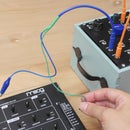Introduction: How to Sew a Set-in Sleeve With Ease
The armhole of the sleeve is slightly longer that the armhole of the body, this creates more volume in the sleeve cap for your shoulder and upper arm. Typically a sleeve will have anywhere from 3/4" - 1" of extra length to ease into the armhole measurement. This sleeve has about 3/4" of ease. In the steps below I will go through how to ease the extra length in while setting in your sleeve.
Step 1: Terms and Cutting
There are several terms and parts of a sleeve that need to be identified before you cut and sew. A sleeve pattern, whether bought or hand-drafted, will have notches, grain line, pattern piece name and how many to cut.
Selvedge and Grain Line
Grain line is used to align the pattern correctly on the fabric. Fabric is sold by-the-yard, how ever much you need, it's cut off of a bolt. The yardage gets measured along a finished edge that is produced as the fabric is woven on a loom. These edges are called the selvedge, run the grain line parallel to these edges. This way, you clothes will hang and hold their structure correctly once sewn together.
Notches
Look for a ▲ or T shaped mark, this will locate your notches. There should be one at the top of the sleeve cap and some annotating the front and back of you sleeve. These notches will also come in handy with knowing where to distribute the ease of the sleeve cap.
When you are cutting the pattern piece out, snip the notches in 3/16" in from the cut edge.
Step 2: Find Out the Ease
Take a soft measuring tape and measure the sleeve cap.
Pin the Front and Back together at the shoulder seam and measure the armhole. Alternatively, you can walk your pattern.
Take note of your measurements, then subtract the armhole from the sleeve cap measurement. It should be somewhere between 1" - 2", this is your ease. The sleeve I am working with has 1".
Step 3: Sew Body and Sleeve
Sew the front and back of the garment along the shoulder and side seam. Sew up any bust darts that may be part of the armhole too. Press the side seam seam allowance (SA) open.
Sew the sleeve along the underarm seam, press open the SA and turn inside-out.
Step 4: Easing Stitch
Some patterns will have marks specifically "front ease point" and "back ease point". I use the front and back notches as my guides.
Set the sewing machine to the longest stitch length, also known as the basting stitch.
Use the ease points or notches, starting at one, sewing 1/4" - 3/8" from the edge, depending on your SA.
Step 5: Set in Sleeve
Line up notches and underarm seam with side seam. Make sure you pin the right side of the sleeve to the right side of the body.
Pin first at underarm, shoulder and notches. Distribute the sleeve ease starting about 1" up from the front and back notches. Start pinning around the sleeve cap in equal parts, distributing the ease evenly. If you have more ease, such as 2", use more pins than I have illustrated.
Sew
Sew the sleeve in, starting at the underarm and go slowly. Smooth out and redistribute the ease as you get closer to the shoulder point. For me, I use a combination of the easing stitch method and knowing how to manipulate the fabric as I go. As you sew the presser foot can be lifted up and possible pinches can be redistributed like this.
Step 6: How to Fix a Tuck
If you accidentally sew in a tuck, pinching the fabric on one side, it's very easy to fix.
Take a seam ripper, undo the tuck and a few stitches on either side. Smooth the tuck out and pin in place. Go to the sewing machine and close the armhole stitch line.
Step 7: Press
From the inside, press the SA towards the inside of the sleeve cap. From the outside, press using a sleeve ironing board or the smaller round end of a normal sized ironing board. Use a little bit of steam to shape and set the round of the sleeve cap.













